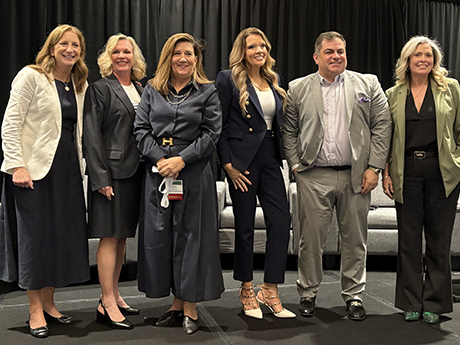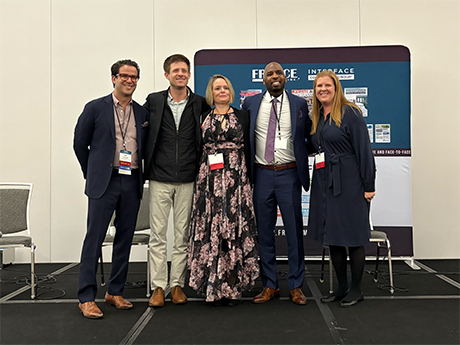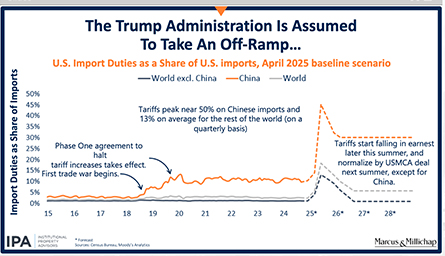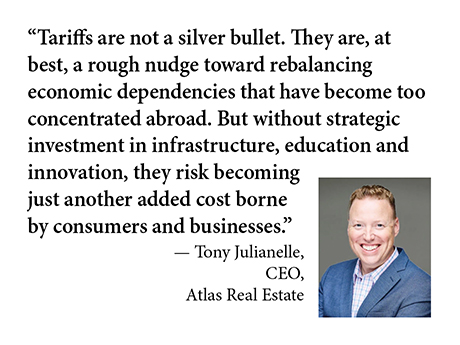DALLAS — What’s in a name? Plenty, according to the industry professionals that operate and market active adult communities. Jane Arthur Roslovic, co-founder and CEO of Treplus Communities, says that “if anybody called [her] a senior” she’d “smack them.” Roslovic’s quip came during a panel discussion — titled “Operating and Marketing: Best Practices in Lease-Up, Sales and Programming” — at the 5th annual InterFace Active Adult conference. The daylong event took place Wednesday, May 7, at The Westin Las Colinas in Dallas. Editor’s note: InterFace Conference Group, a division of France Media Inc., produces networking and educational conferences for commercial real estate executives. To sign up for email announcements about specific events, visit www.interfaceconferencegroup.com/subscribe. Roslovic and her fellow panelists argued that the same reluctance to be branded as a “senior” extends to prospective residents of active adult communities. The key to attracting and retaining residents, the panelists insisted, is to not only provide excellent product but also understand and cater to the public’s perception of age-restricted properties. Active adult communities are age-eligible, market-rate multifamily properties with enhanced lifestyle programming, according to the National Investment Center for Seniors Housing & Care (NIC). Unlike independent living communities, active adult properties do not …
Features
By Ashley O’Connor, executive managing director at MGAC Large-scale mixed-use developments are reshaping urban landscapes, offering opportunities to reimagine cities as more appealing places to live, work and visit. Unlike traditional single-use developments, these projects blend various real estate verticals — residential, commercial, recreational — into cohesive ecosystems. The versatility of these projects both mitigates risks during economic downturns, such as oversupply in specific sectors, and fosters resilience and adaptability, making them stand out as sustainable investments in an evolving urban environment. Enhancing Visual, Functional Landscapes The shift away from monolithic single-use buildings has transformed skylines, replacing them with dynamic, multi-purpose structures that blend into their surroundings. These projects often feature green spaces, public art installations and architectural elements that enhance aesthetics and functionality. For instance, the redevelopment of the Century Plaza Hotel in Los Angeles demonstrates how historical preservation can coexist with modern innovation. Once celebrated for its mid-century design, the property’s transformation added sleek residential towers while maintaining its iconic charm, creating a vibrant hub that reflects the city’s evolving identity. Similarly, the Etobicoke Civic Center in Toronto illustrates how well-designed mixed-use developments contribute to urban appeal. By combining civic, residential and commercial spaces into a single 800,000-square-foot …
ATLANTA — Affordable housing is facing a tumultuous second half of the year. Tariffs on building materials such as lumber, steel and aluminum are slowing development activity as they elevate construction costs. Investment sales are also likely to be impacted by unstable economic conditions in the affordable housing sector, where many transactions are conducted within a limited budget due to the nature of income restrictions for renters. Amid high costs and trade uncertainty, many investors are making the decision to stay on the sidelines or invest in markets with more stable conditions. Editor’s note: InterFace Conference Group, a division of France Media Inc., produces networking and educational conferences for commercial real estate executives. To sign up for email announcements about specific events, visit www.interfaceconferencegroup.com/subscribe. “The most experienced, best qualified buyers are being careful about what they purchase,” said Kyle Shoemaker, a managing director at Affordable Housing Investment Brokerage. The Downers Grove, Illinois-based company arranges acquisitions and dispositions of Section 8, Section 42, low-income housing tax credit (LIHTC) and tax credit housing. “The affordable housing sector was heated in 2021,” Shoemaker continued. “At that point in time, we were getting more calls than ever from multifamily investors who were interested in entering the affordable …
By Katie Sloan AUSTIN, TEXAS — The ‘State of the Industry’ panel at the 17th annual InterFace Student Housing conference held more of a trepidatious tone than heard in recent years. While pre-leasing levels and rental rates are still above historical norms, the industry is seeing a slight deceleration in pre-leasing speed and rate growth, leading some to question what the industry has in store for the year ahead. The discussion — held on April 10 in Austin, Texas — was moderated by Alex O’Brien, CEO with Cardinal Group. The best way to characterize the industry this year is hesitant according to Ryan Lang, executive vice chairman with Newmark, who believes investor reluctance is largely due to pre-leasing numbers falling a couple of points behind levels seen at this time last year. Still, levels are trending far ahead of pre-leasing levels seen in 2019, lending to confidence overall in the sector. Editor’s note: InterFace Conference Group, a division of France Media Inc., produces networking and educational conferences for commercial real estate executives. To sign up for email announcements about specific events, visit www.interfaceconferencegroup.com/subscribe. “The past two years were unprecedented from a leasing perspective with properties leasing up the fastest and with the highest rents growths …
By Hayden Spiess Investment firm and asset manager Nuveen has a dedicated “What is C-PACE?” page on its website, outlining the basics of this unique type of financing. That the firm sees such a fact sheet as necessary is unsurprising, given that within the commercial real estate industry, Commercial Property Assessed Clean Energy (C-PACE) financing carries less familiarity relative to other financing products. Anne Hill, senior vice president of Bayview PACE, says that “there are some misconceptions out there” and that there is “some confusion around the product.” Lenders say that now though, despite the fact that some misinformation and lack of awareness persist, the tool is rapidly gaining favor among borrowers that recognize its exceptional utility, especially in the volatile environment of today. Origins Originated in Berkeley, California, in 2008, commercial property assessed clean energy (C-PACE) financing is now available in 40 states throughout the country. C-PACE serves as an alternative funding source for commercial projects that qualify on the basis that they will result in reduced energy and water usage and greater building efficiency. “When the program was created, the idea was that the government wanted to allow property owners an easier way to finance energy efficiency …
By Katie Sloan AUSTIN, TEXAS — The 17th annual InterFace Student Housing conference, held April 9-11 at the JW Marriott in Austin, Texas, saw more than 1,500 student housing industry executives gather for educational sessions and networking. The conference’s first full day kicked off on April 10 with the ‘Power Panel,’ which brought together a group of high-level executives from several of the top companies in the sector to discuss their outlook for the year ahead. Moderator Peter Katz, executive managing director with Institutional Property Advisors, began the discussion by highlighting a few growing concerns in the current economic environment. Chief among them were the potential impact of global tariffs on equity and development in student housing and the possibility of an economic slowdown or even an impending recession. Editor’s note: InterFace Conference Group, a division of France Media Inc., produces networking and educational conferences for commercial real estate executives. To sign up for email announcements about specific events, visit www.interfaceconferencegroup.com/subscribe. Still, the student housing sector has proven time and time again that it is a resilient asset class. “If we look back at the global financial crisis and COVID-19 pandemic, we’ve witnessed that the student housing sector is pandemic- and recession-resistant,” said Katz. “Institutional …
Content PartnerDevelopmentFeaturesIndustrialLeasing ActivityLee & AssociatesMidwestMultifamilyNortheastOfficeRetailSoutheastTexasUncategorizedWestern
Lee & Associates: Tariffs Add to Q1 Industrial Challenges; All Sectors See Constrained Development
The end of the first quarter of 2025 saw market uncertainty in the face of new U.S. trade and tariff policies combined with an unclear geopolitical outlook, according to Lee & Associates’ 2025 Q1 North America Market Report. The effect of these concerns within the commercial real estate world are most evident in the industrial sector, which is also contending with oversupply and softening rent growth. Development is slow across property types. Retail, despite high-profile store closures in early 2025, remains historically tight on space as years of underbuilding keep availabilities near record lows. Office demand has stabilized in several major metros following years of contraction, though vacancy remains elevated. The pipeline of new construction is both drying up and favoring new types of tenants beyond traditional office spaces. Multifamily is seeing strong tenant demand in certain markets despite a flood of new deliveries. Lee & Associates has made their full market report available here (click through for detailed breakdowns and city-by-city information). The information below for the industrial, office, retail and multifamily sectors offers clarity on market-wide demand, rent growth trends and challenges likely to shape trajectories throughout 2025. Industrial Overview: Soft Markets Face Tariff Disruptions North America’s industrial markets …
By Taylor Williams Editor’s note: This article covers the opening session (approximately the first 20 minutes) of the “Real Recession Risk or Temporary Distraction?” webcast. To watch a replay of the entire event and listen to the subsequent conversation, please use the link at the bottom of the page. At least for one week in April, Mark Zandi was to economics what Tony Romo has been to professional football — a broadcaster who sees the play before it happens. As a featured speaker on a Marcus & Millichap webcast titled “Real Recession Risk or Temporary Distraction?” that took place on Monday, April 21, the chief economist for Moody’s Analytics expressed major concerns over the impacts that the Trump administration’s tariffs had on business sentiment and investor confidence. Zandi qualified his analysis by stating unequivocally that while damage had already been done, he expected the administration to take an “off ramp,” and revise its tariff policies. Doing so would be crucial to avoiding further sinking the stock and bond markets and potentially hurting the commercial real estate market too by extension, Zandi said. His prediction, which was made as a market selloff was unfolding — appeared to come true almost instantaneously. …
Affordable HousingContent PartnerFeaturesLoansMidwestMultifamilyNortheastRegions Real Estate Capital MarketsSoutheastTexasWestern
Looking to Finance Your Multifamily Property? Compare Fannie Mae, Freddie Mac Small Balance Loan Options
By Ann Atkinson, Regions Real Estate Capital Markets Finance options for owner/operators of multifamily properties are consistently available via Fannie Mae and Freddie Mac. Both government-sponsored entities (GSEs), are governed by the Federal Housing Finance Agency (FHFA) and share a clear mission to support the health of the country’s housing market and its existing multifamily supply by providing financing options to borrowers. Loans Accessible for Affordable, Workforce Properties The support provided by both Fannie Mae and Freddie Mac to multifamily housing notably extends beyond market-rate rental properties, with both agencies dedicated to the availability of affordable and workforce housing units to low-income renters. Thus, Fannie Mae and Freddie Mac offer good loan options to consider for owner/operators active in these multifamily subsets. Let’s compare their offerings specific to small balance loans, as these are often the appropriate solutions for this range of multifamily properties. Both Fannie Mae and Freddie Mac programs offer financing for the acquisition or refinance of stabilized multifamily properties. The properties must include five or more residential units and be stabilized. The agencies define stabilized as 90 percent occupancy for 90 days. In addition, both programs offer the following product features for small loans: Let’s now …
By Tony Julianelle, CEO, Atlas Real Estate The recent surge of tariffs on imports of goods from a bevy of countries has triggered a new round of economic debates — and for good reason. As the situation unfolds and develops, three questions keep coming up that are especially important for real estate investors, business leaders and homeowners alike: • Will tariffs significantly raise building costs and home prices, or are these fears overstated? • Could tariffs genuinely foster economic stability and stimulate American manufacturing and jobs? • How can the real estate community strategically navigate or even capitalize on these changes? Let’s break it down. Are Higher Building Costs, Home Prices Inevitable? In the short term, it’s hard to ignore the facts: tariffs are taxes, and when imported building materials are taxed, construction costs go up. The National Association of Home Builders estimates that recent tariffs could raise the cost of building a new home by about $9,200 on average. For anyone already feeling the squeeze of high mortgage rates and limited inventory, this is unwelcome news. But it’s important to separate short-term reaction from long-term reality. Tariffs will create localized inflationary pressures, but their magnitude compared to other market forces — land …











